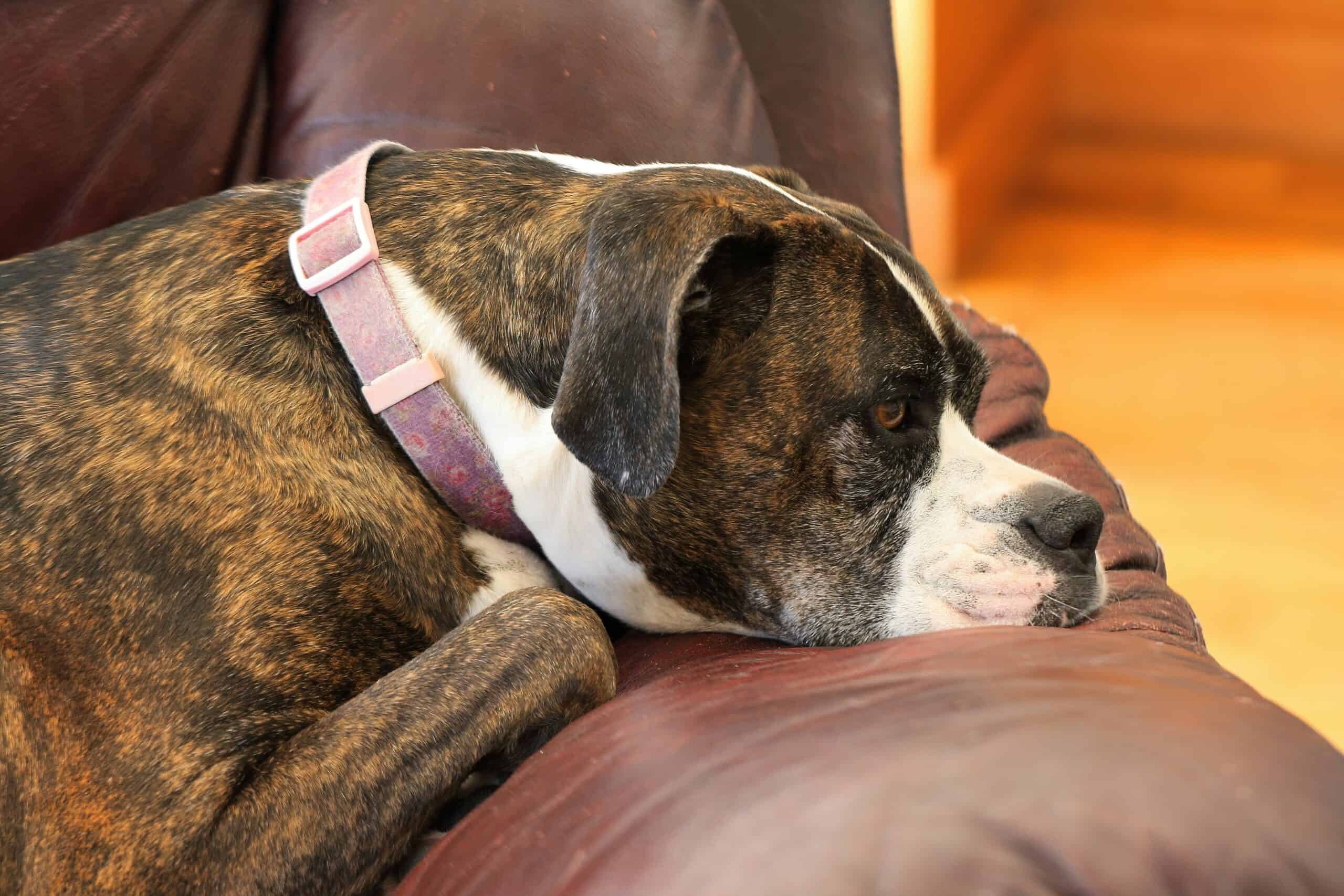Separation Anxiety in Dogs: Signs, Causes, and Strategies for Preventing It
Posted by Lora Shaw on May 1, 2024

Separation anxiety is the fear of being left alone and the unknown that follows, and it can pose challenges for both dogs and their owners. We empathize with the difficulty of leaving a pet who struggles with being left alone, which is why we’ve compiled essential information below to recognize, prevent, and address this issue.
Key Takeaways Found in this Post
- Separation anxiety in dogs can be a major concern for pet owners and can be caused by poor socialization and changes in family members, among other things
- Common signs of separation anxiety in dogs include excessive barking, destructive behavior, pacing, escaping, and even fecal and urinary issues
- For the best results, some of the tactics our team recommends for overcoming separation anxiety include providing enrichment, using crate training, and maintaining a consistent routine
Understanding Dog Separation Anxiety
Dog separation anxiety can be a major concern for pet owners. You need to be able to leave your house regularly without worrying that it will negatively affect your pet. Discovering what causes separation anxiety and the signs to look out for will help you address this issue effectively.
What Causes This Anxiety?
There are many factors that can lead to separation anxiety, such as the breed of dog in question, as some are more prone to anxiety than others. Another factor is your dog’s personality, as some dogs are naturally more independent than others. Additionally, some external influences that may lead to this anxiety include:
- Poor socialization as a young puppy
- A dog never being left alone in their formative years
- Changes in family members or pets (new addition, death, etc.)
- History of actual abandonment from previous owners
- A traumatic event has happened (a move, big change, etc.)
Common Signs of Separation Anxiety
Separation anxiety in dogs can manifest in many ways and it’s essential you recognize these signs before they worsen or escalate into more severe behavioral issues. Some of the common signs to look out for that may indicate anxiety include:
- Barking, crying or howling – Vocalization is a big indicator when dogs are feeling anxious. If your dog is whining or howling in a frantic way when you leave, that is a sign of dog separation anxiety.
- Destructive behavior – When in distress, dogs can turn that anxiety into destructive behavior. This can include chewing on objects or destroying any household objects when left alone. This is definitely a concern for pet owners since these behaviors are not only problematic, but they could lead to injury.
- Fecal or urinary incontinence – If your dog is fully potty trained and they urinate or defecate when left alone or when separated, it’s probably because of separation anxiety. Similar to humans, dogs can get nervous to the point that they lose bladder and bowel control, so keeping stressful situations to a minimum is key.
- Pacing – When separated from their guardian, some pets will pace either in straight lines or circular patterns, showcasing classic symptoms of separation anxiety in dogs.
- Escaping – Some dogs with anxiety will engage in an escape behavior when left alone without their owner. Not only is there the concern that they could hurt themselves, but they could also get lost depending on where you’re leaving them.
Tips for Dealing with Separation Anxiety in Dogs
Dogs are social creatures and love to be surrounded by us much of the time. While we always love to be with our furry friends, it’s important that they receive some alone time, as a lack of it can worsen separation anxiety in dogs.
By addressing the anxiety head on and getting past it, you can leave your house peacefully knowing your dog is comfortable and happy alone at home. Below are some tips that we’ve found can help treat or possibly prevent this type of behavior.
Provide Enrichment
Enrichment toys are a great way to teach your pets to entertain themselves, and they’re ideal for managing dog separation anxiety, as they provide mental stimulation, comfort, and distraction during alone time.
Use Crate Training
One way you can help or possibly prevent separation anxiety is crate training. You can start by giving your dog a long-lasting treat in the crate so they will be excited to go in there. Over time, they’ll start to associate their crate with rest, sleeping, and eating, soothing any anxiety they feel when you’re gone.
Exercise
Your dog should be receiving exercise every day regardless, but if you can get your dog’s energy out before you leave the house, they’ll be tired and less anxious. A dog who is well-exercised and stimulated is more likely to be better behaved when you step out of the house.
Maintain a Routine
Dogs love a consistent routine so helping them understand what to expect will help them not be blindsided when you have to be away. Setting a morning routine for them before you have to leave for eating, walking, and going outside will help prepare them for your departure.
Practice Leaving Quietly
You want to avoid making your exit a dramatic event as it could stress your pet out and ultimately intensify separation anxiety in dogs. The goal is to not draw attention or make a big deal when you’re getting ready to leave. When it’s time to go, give them their treat and walk out the door.
Create a Safe Space
Everybody loves to have a cozy spot and dogs are no different. You want to create a space for your dog where they feel comfortable and protected. It could possibly be a crate, a back room, or their favorite couch to relax on while you’re gone. Remember, you want to create a happy space, so be sure to leave them with their favorite toy or treat to enjoy.
FAQs on Dog Separation Anxiety
Can puppies experience separation anxiety?
Most definitely they can. While it may not be very common, there is a period of time where they may become more attached to their owners and separation anxiety could develop.
Does crate training help with this anxiety?
Crate training can definitely be a vital tool when it comes to managing dog separation anxiety or preventing it completely. If introduced properly, the crate will act as a safe space when they are left alone and going to it will become a positive experience for them.
Is it possible to outgrow dog separation anxiety?
Some dogs may be able to outgrow separation anxiety as they grow older and become more confident. Other severe cases typically require management strategies to improve.
Can separation anxiety in dogs be managed without professional help?
In mild cases, you may be able to manage symptoms through behavior modification techniques and consistent training. However, in severe cases where your pet is not responding to this at home, you may need to seek professional help.
Allow Pet Palace to Give Your Dog Some Company
If you’d rather avoid leaving your dog alone, our team at Pet Palace is more than happy to keep them company while you’re away. We are here to provide companionship and alleviate any possible dog separation anxiety.
Through our customized care, your dog will feel right at home. Whether you are going on vacation or are just off to work, we offer dog boarding services and day care for you. This is the best way to ensure that your dog is getting the attention and care they deserve throughout the day.
By choosing Pet Palace, you’ll reap a variety of benefits that include:
- Custom pricing – You only pay for what your pet needs and nothing more. Our à la carte pricing means you get more control over what services your pet receives while in our care.
- 24-hr Pet Safe Program – We have safe and secure accommodations overseen by experienced team members at all times.
- Spacious and clean facilities – Every pet at our facility gets lots of space to move around. Additionally, bedding and water are changed daily.
- High staff-to-pet ratio – Our high ratio means that we can stick to that daily routine that is so important in dealing with dog separation anxiety. We can ensure that your pet is fed at certain times, distribute medication, and customize your pet’s experience to meet any needs.
- Supervised outdoor play and potty breaks – Dogs are routinely taken outdoors by our trained staff members for playtime and human interaction.
Lastly, we offer webcam access for select suites so that you can check on your furry friend at any time while you’re away.
Contact Us to Book Today
If you’re wanting to learn more about our services and what makes Pet Palace the ideal environment for your pet when you can’t be there, contact our team today. With our unique model designed with your pet’s comfort in mind, you can have peace of mind while you’re away.

Categories: All Posts, Dogs, Tips for Your Pets
Archives
Recent Articles
Categories
Monthly Archive
- April 2025
- March 2025
- February 2025
- January 2025
- December 2024
- November 2024
- October 2024
- September 2024
- August 2024
- July 2024
- June 2024
- May 2024
- April 2024
- March 2024
- February 2024
- January 2024
- December 2023
- November 2023
- October 2023
- August 2023
- July 2023
- June 2023
- May 2023
- April 2023
- March 2023
- February 2023
- January 2023
- December 2022
- November 2022
- October 2022
- August 2022
- July 2022
- June 2022
- April 2022
- March 2022
- February 2022
- November 2021
- October 2021
- November 2020
- September 2020
- July 2020
- March 2020
- January 2020
- November 2019
- September 2019
- July 2019
- March 2019
- January 2019
- December 2018
- November 2018
- October 2018
- August 2018
- July 2018
- June 2018
- May 2018
- April 2018
- March 2018
- February 2018
- January 2018
- December 2017
- November 2017
- October 2017
- September 2017
- August 2017
- July 2017
- June 2017
- May 2017
- April 2017
- March 2017
- February 2017
- January 2017
- December 2016
- November 2016
- September 2016
- August 2016
- July 2016
- June 2016
- May 2016
- April 2016
- March 2016
- February 2016
- December 2015
- November 2015
- October 2015
- September 2015
- August 2015
- July 2015
- May 2015
- March 2015
- February 2015
- January 2015
- December 2014
- November 2014
- September 2014
- August 2014
- July 2014
- June 2014
- May 2014
- March 2014
- February 2014
- January 2014
- December 2013
- November 2013
- October 2013
- September 2013
- August 2013
- June 2013
- May 2013
- March 2013
